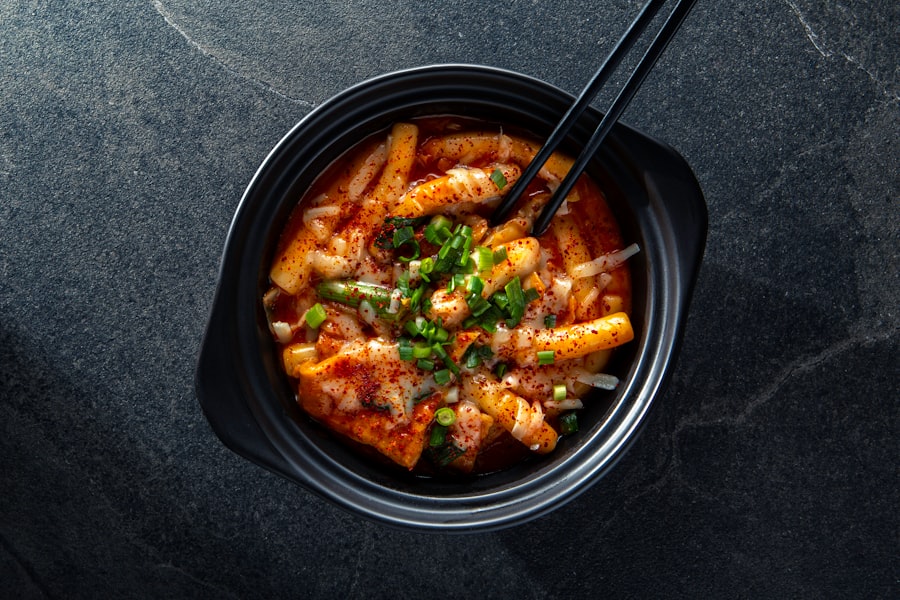Jamie Oliver, a culinary icon known for his approachable cooking style and emphasis on fresh ingredients, has captivated home cooks around the world with his vibrant recipes. Among his many offerings, the Thai Red Curry stands out as a dish that beautifully encapsulates the essence of Thai cuisine. This recipe is not just a meal; it is an experience that transports you to the bustling streets of Thailand, where the aroma of spices and herbs fills the air.
The combination of creamy coconut milk, aromatic spices, and fresh vegetables creates a harmonious balance of flavors that is both comforting and invigorating. The beauty of Jamie Oliver’s Thai Red Curry lies in its versatility. It can be tailored to suit various dietary preferences, whether you are a meat lover, vegetarian, or vegan.
The recipe encourages creativity, allowing cooks to experiment with different proteins and vegetables while maintaining the core essence of the dish. With its rich flavors and vibrant colors, this curry is perfect for family dinners, gatherings with friends, or even a cozy night in. As we delve into the ingredients and preparation methods, you’ll discover how simple it is to create this delightful dish in your own kitchen.
Ingredients needed for Jamie Oliver’s Thai Red Curry Recipe
The Foundation of Flavor
The foundation of this dish is the red curry paste, which is typically made from a blend of red chilies, garlic, lemongrass, galangal, and other spices. While you can purchase pre-made curry paste from the store, making your own can elevate the dish to new heights.
Essential Ingredients
If you choose to go the homemade route, consider using dried red chilies soaked in water to create a paste that packs a punch. In addition to the curry paste, coconut milk is essential for achieving that creamy texture and rich flavor profile. Jamie often recommends using full-fat coconut milk for a luxurious mouthfeel.
Adding Texture and Flavor
Fresh vegetables such as bell peppers, zucchini, and snap peas add color and crunch, while proteins like chicken, shrimp, or tofu provide substance. Fresh herbs like basil and cilantro are crucial for garnishing the dish and adding a burst of freshness. Don’t forget about lime juice for acidity and fish sauce or soy sauce for umami depth. Each ingredient plays a vital role in creating a well-rounded dish that is both satisfying and delicious.
Step-by-step instructions for making Jamie Oliver’s Thai Red Curry

Creating Jamie Oliver’s Thai Red Curry is a straightforward process that can be broken down into several key steps. Begin by preparing your ingredients: chop your chosen protein into bite-sized pieces and slice your vegetables into uniform shapes for even cooking. If you’re using homemade curry paste, blend your soaked chilies with garlic, lemongrass, and galangal until smooth.
This step is crucial as it sets the flavor foundation for your curry. Next, heat a generous splash of vegetable oil in a large pan over medium heat. Once the oil is hot, add the red curry paste and sauté it for a couple of minutes until it becomes fragrant.
This step helps to release the essential oils from the spices, intensifying the flavor of your curry. Afterward, pour in the coconut milk and stir well to combine with the curry paste. Allow this mixture to simmer gently for about five minutes; this will help meld the flavors together beautifully.
Once the coconut milk has thickened slightly, add your protein of choice to the pan. If you’re using chicken or shrimp, cook until they are just done; if you’re using tofu, ensure it is heated through and slightly crispy on the outside. After adding your protein, toss in your vegetables and let them cook until they are tender yet still vibrant in color.
This usually takes about five to seven minutes. Finally, finish off your curry with a squeeze of lime juice and a splash of fish sauce or soy sauce for that essential umami kick. Serve hot over steamed jasmine rice or noodles for a complete meal.
Tips and tricks for perfecting Jamie Oliver’s Thai Red Curry
| Ingredients | Quantity |
|---|---|
| Red curry paste | 2 tablespoons |
| Coconut milk | 400ml |
| Chicken breast | 2, sliced |
| Vegetables (bell peppers, bamboo shoots, etc.) | As desired |
| Fish sauce | 2 tablespoons |
| Sugar | 1 tablespoon |
| Thai basil leaves | As desired |
| Vegetable oil | 2 tablespoons |
To truly master Jamie Oliver’s Thai Red Curry, there are several tips and tricks that can enhance your cooking experience and elevate the final dish. One important aspect is to balance flavors effectively. Thai cuisine is known for its harmonious blend of sweet, salty, sour, and spicy elements.
If you find your curry lacking depth, consider adjusting the seasoning by adding more lime juice for acidity or sugar for sweetness. A pinch of salt can also help bring out the flavors of the other ingredients. Another key tip is to pay attention to cooking times for your vegetables.
Overcooking can lead to mushy vegetables that lose their vibrant color and crunch. To maintain their texture and nutritional value, add heartier vegetables like carrots or broccoli earlier in the cooking process while adding more delicate ones like bell peppers or snap peas towards the end. This ensures that each component retains its integrity while contributing to the overall dish.
Additionally, presentation plays a significant role in enjoying any meal. When serving your Thai Red Curry, consider garnishing it with fresh herbs like cilantro or Thai basil, which not only add visual appeal but also enhance the flavor profile. A sprinkle of chopped peanuts or cashews can provide an unexpected crunch that complements the creamy texture of the curry beautifully.
Serving suggestions and accompaniments for Jamie Oliver’s Thai Red Curry
When it comes to serving Jamie Oliver’s Thai Red Curry, there are numerous accompaniments that can enhance the dining experience. Traditionally, this dish is served over jasmine rice, which absorbs the rich flavors of the curry while providing a neutral base that balances out the spices. The fragrant rice complements the dish perfectly and allows each bite to be a delightful combination of textures and tastes.
For those looking to add more variety to their meal, consider serving the curry alongside fresh spring rolls or crispy vegetable tempura. These light appetizers can provide a refreshing contrast to the richness of the curry. Additionally, a simple cucumber salad dressed with lime juice and fish sauce can offer a zesty crunch that cuts through the creaminess of the dish.
If you’re hosting a dinner party or gathering, consider creating a Thai-inspired feast by offering multiple dishes alongside your red curry. Dishes such as Pad Thai or green papaya salad can create an exciting spread that showcases different aspects of Thai cuisine. This not only makes for an impressive presentation but also allows guests to explore various flavors and textures throughout their meal.
Variations and substitutions for Jamie Oliver’s Thai Red Curry Recipe

Vegetarian and Protein Options
One of the most appealing aspects of Jamie Oliver’s Thai Red Curry recipe is its adaptability. Depending on dietary preferences or ingredient availability, there are numerous variations you can explore without compromising on flavor. For instance, if you’re looking for a vegetarian option, simply replace meat with an assortment of seasonal vegetables such as eggplant, mushrooms, or butternut squash. Tofu can also be used as a protein source; opt for firm tofu that can hold its shape during cooking.
Adjusting Flavor and Spice
If you’re aiming for a lighter version of this dish, consider using light coconut milk instead of full-fat coconut milk. While this will reduce some richness, you can compensate by adding extra spices or herbs to maintain flavor intensity. For those who enjoy heat, feel free to increase the amount of red curry paste or add fresh chilies according to your spice tolerance.
Accommodating Dietary Restrictions and Preferences
For individuals with specific dietary restrictions such as gluten intolerance, substituting fish sauce with tamari or coconut aminos can provide similar umami notes without gluten content. Additionally, if you prefer a different flavor profile altogether, experimenting with green curry paste instead of red can yield an entirely new dish while still retaining that signature Thai essence.
In conclusion, Jamie Oliver’s Thai Red Curry recipe offers an exciting culinary adventure filled with vibrant flavors and endless possibilities for customization. Whether you stick closely to his original recipe or make it your own through variations and substitutions, this dish promises to be a delightful addition to any meal plan.


















